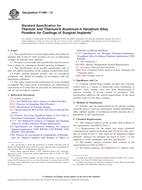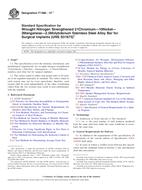Potřebujeme váš souhlas k využití jednotlivých dat, aby se vám mimo jiné mohly ukazovat informace týkající se vašich zájmů. Souhlas udělíte kliknutím na tlačítko „OK“.
ASTM F1714-96(2013)
Standard Guide for Gravimetric Wear Assessment of Prosthetic Hip Designs in Simulator Devices
Automaticky přeložený název:
Standardní příručka pro Gravimetrická opotřebení posuzování protetické Hip vzory v Simulator zařízení
NORMA vydána dne 15.3.2013
Informace o normě:
Označení normy: ASTM F1714-96(2013)
Poznámka: NEPLATNÁ
Datum vydání normy: 15.3.2013
Kód zboží: NS-51274
Počet stran: 8
Přibližná hmotnost: 24 g (0.05 liber)
Země: Americká technická norma
Kategorie: Technické normy ASTM
Kategorie - podobné normy:
Anotace textu normy ASTM F1714-96(2013) :
Keywords:
ICS Number Code 11.040.40 (Implants for surgery, prothetics and orthotics)
Doplňující informace
| Significance and Use | ||||||||||||||||||||||||||
|
3.1 This guide uses a weight-loss method of wear determination for the polymeric components used with hip joint prostheses, using serum or demonstrated equivalent fluid for lubrication, and running under a dynamic load profile representative of the human hip-joint forces during walking 3.2 While wear results in a change in the physical dimensions of the specimen, it is distinct from dimensional changes due to creep or plastic deformation, in that wear generally results in the removal of material in the form of polymeric debris particles, causing a loss in weight of the specimen. 3.3 This guide for measuring wear of the polymeric component is suitable for various simulator devices. These techniques can be used with metal, ceramic, carbon, polymeric, and composite counter faces bearing against a polymeric material (for example, polyethylene, polyacetal, and so forth). This weight-loss method, therefore, has universal application for wear studies of total hip replacements that feature polymeric bearings. This weight-loss method has not been validated for high-density material bearing systems, such as metal-metal, carbon-carbon, or ceramic-ceramic. Progressive wear of such rigid bearing combinations generally has been monitored using a linear, variable-displacement transducers or by other profilometric techniques. |
||||||||||||||||||||||||||
| 1. Scope | ||||||||||||||||||||||||||
|
1.1 This guide describes a laboratory method using a weight-loss technique for evaluating the wear properties of materials or devices, or both, which are being considered for use as bearing surfaces of human-hip-joint replacement prostheses. The hip prostheses are evaluated in a device intended to simulate the tribological conditions encountered in the human hip joint, for example, use of a fluid such as bovine serum, or equivalent pseudosynovial fluid shown to simulate similar wear mechanisms and debris generation as found in vivo, and test frequencies of 1 Hz or less. 1.2 Since the hip simulator method permits the use of actual implant designs, materials, and physiological load/motion combinations, it can represent a more physiological simulation than basic wear-screening tests, such as pin-on-disk (see Practice F732) or ring-on-disk (see ISO 6474). 1.3 It is the intent of this guide to rank the combination of implant designs and materials with regard to material wear-rates, under simulated physiological conditions. It must be recognized, however, that there are many possible variations in the in vivo conditions, a single laboratory simulation with a fixed set of parameters may not be universally representative. 1.4 The reference materials for the comparative evaluation of candidate materials, new devices, or components, or a combination thereof, shall be the wear rate of extruded or compression-molded, ultra-high molecular weight (UHMW) polyethylene (see Specification F648) bearing against standard counter faces [stainless steel (see Specification F138); cobalt-chromium-molybdenum alloy (see Specification F75); thermomechanically processed cobalt chrome (see Specification F799); alumina ceramic (see Specification F603)], having typical prosthetic quality, surface finish, and geometry similar to those with established clinical history. These reference materials will be tested under the same wear conditions as the candidate materials. 1.5 The values stated in SI units are to be regarded as standard. No other units of measurement are included in this standard. |
||||||||||||||||||||||||||
| 2. Referenced Documents | ||||||||||||||||||||||||||
|
Podobné normy:
Historická
1.4.2009
Historická
1.3.2012
Historická
1.10.2012
Historická
1.12.2011
Historická
1.6.2013
Historická
1.3.2014
Doporučujeme:
Aktualizace zákonů
Chcete mít jistotu o platnosti užívaných předpisů?
Nabízíme Vám řešení, abyste mohli používat stále platné (aktuální) legislativní předpisy.
Chcete vědět více informací? Podívejte se na tuto stránku.



 ASTM F1538-03(2009)..
ASTM F1538-03(2009).. ASTM F1580-12
ASTM F1580-12 ASTM F1581-08(2012)..
ASTM F1581-08(2012).. ASTM F1582-98(2011)..
ASTM F1582-98(2011).. ASTM F1586-13e1
ASTM F1586-13e1 ASTM F1609-08(2014)..
ASTM F1609-08(2014)..
 Cookies
Cookies
